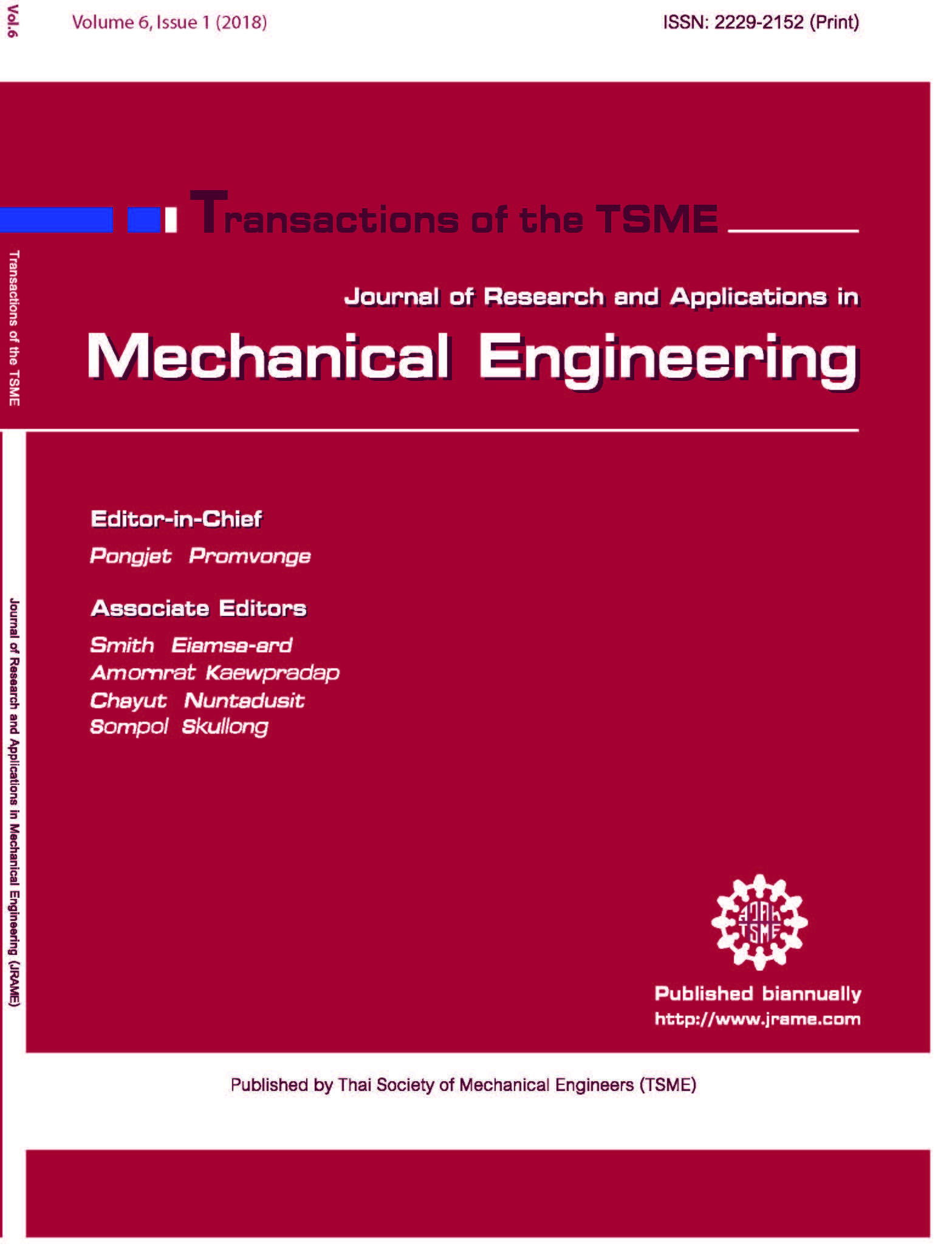Surrounding gas pressure and oxygen concentration dependence of the spray auto-ignition phenomenon for ethanol-diethyl ether blended fuels
Main Article Content
Abstract
This study deals with the development of controlled-ignition technology for high performance compression ignition alcohol engines. The objective of this study is quantitative evaluation of main factors that influence auto-ignition of an alcohol spray. The quantitative evaluation that can be finally as the database in a form of 3D-mapping of ignition delay is now in progress. When the mapping is completed by a number of systematic experiments, engine control logic is able to be established and high performance alcohol engines are developed. This paper mainly focuses on the effect of surrounding gas pressure and oxygen content on auto-ignition. Spray mixture formation up to auto-ignition of ED (Ethanol-Diethyl ether) blended fuels in a large constant volume electrical heating chamber was visualized by shadowgraph method. The results showed that ignition delay was depended on surrounding gas pressure and oxygen concentration. However, ED blend fuels showed small dependence of O2 content on ignition delay when its value was higher than 30%. In further O2 rich condition of 35%, diffusion combustion was observed when ignition position was shifted to upstream region of a spray with increasing of O2 content for diethyl ether rich ED blended fuels.
Article Details
This work is licensed under a Creative Commons Attribution-NonCommercial-ShareAlike 4.0 International License.
References
[2] Ogawa, H., Chikahisa, T., Miyamoto, N. and Murayama, M. Combustion and performance in multi-spark-assisted diesel engine with alcohol fuels, JSAE Transaction, No.34, 1987, pp.86-93.
[3] Kawahara, N., Tomita, E., Taniguchi, Y. Laser Ignition Characteristics of Ethanol Spray, paper presented in the 21th Symposium (ILASS-Japan) on Atomization, 2012, Tokyo, Japan.
[4] Munsin, R., Laoonual, Y., Jugjai, S., Matsuki, M. et al. Investigation of effects of ignition improvers on ignition delay time of ethanol combustion with rapid compression and expansion machine, SAE Technical Paper, No.2012-01-0854, 2012, pp. 1-11.
[5] Simonsen, H. and Chomial, J. Testing and evaluation of ignition improvers for ethanol in a di diesel engine, SAE Technical Paper, No.952512, 1995, pp. 1-14.
[6] Holland, T.G., Swain, M.N. and Swain, M.R. Using ethanol/diesel mixtures in a compression ignition engine with ignition improver additives, SAE Technical Paper, No.922191, 1992, pp. 1-8.
[7] Hardenberg, H.O. Comparative study of heavy-duty engine operation with diesel fuel and ignition-improved methanol, SAE Technical Paper, No.872093, 1987, pp. 1-16.
[8] Saitoh, H., Uchida, K. and Tateishi, M. Effects of heat supply methods into a spray of alcohol fuels on ignition and combustion characteristics in a small DI alcohol engine, paper presented in the 30th FISITA World Automotive Congress, 2004, Barcelona, Spain.
[9] Saitoh, H., Uchida, K. and Tateishi, M. Effect of Hot EGR on Combustion and Emission Caracteristics in a Diesel Type Alcohol Engine, paper presented in the 24th CIMAC World Congress on Combustion Engine Technology, 2004, Kyoto, Japan.
[10] Uchida, K., Saitoh, H. and Tateishi, M. Combined Effects of Fuel Injection Timing and Hot EGR on Ignition, Combustion and Thermal Efficiency in a Small DI Alcohol Engine, paper presented in the 13th International Pacific Conference on Automotive Engineering, 2005, Gyeongju, Korea.
[11] Saitoh, H. and Uchida, K. Difference of spray mixture formation between gas oil and ethanol in a constant volume electrical heating chamber, SAE Technical Paper, No. 2007-01-3617, 2007, pp. 1-11.
[12] Saitoh, H. and Uchida, K. On the main factors governing auto-ignition phenomenon of alcohol spray – a study from the view point of fuel properties, SAE Int. J. Fuels and Lubricants, Vol. 2(1), 2009, pp.911-920.
[13] Saitoh, H. and Uchida, K. Effect of surrounding gas oxygen content on the spray mixture formation and auto-ignition phenomenon for ethanol-diethyl ether blended fuels, SAE Technical Paper, No.2013-01-0076, 2013, pp. 1-11.
[14] Saitoh, H. and Uchida, K. Surrounding Gas Pressure and Temperature Dependence of the Spray Auto-ignition Phenomenon for Ethanol-Diethyl Ether Blended Fuels, paper presented in the TSME-ICoME 2015 (The 6th TSME International Conference on Mechanical Engineering), 2015, Phetchaburi, Thailand.
[15] Liu, H. and Yao, M. Spray and combustion characteristics of n-butanol in a constant volume combustion chamber at different oxygen concentrations, SAE Technical Paper, No.2011-01-1190, 2011, pp. 1-12.
[16] Wu, H. and Zhang, C. Impacts of acetone on the spray combustion of Acetone-Butanol-Ethanol (ABE)-Diesel blends under low ambient temperature, Journal of Fuel, Vol.142, 2015, pp.109-116.
[17] Wakuri, Y., Fujii, M., Amitani T. and Tsuneya, R. Study on the phenomena of fuel spray in a diesel engine, Bull. of JSME, vol.13(9), 1960. pp. 123-130.


